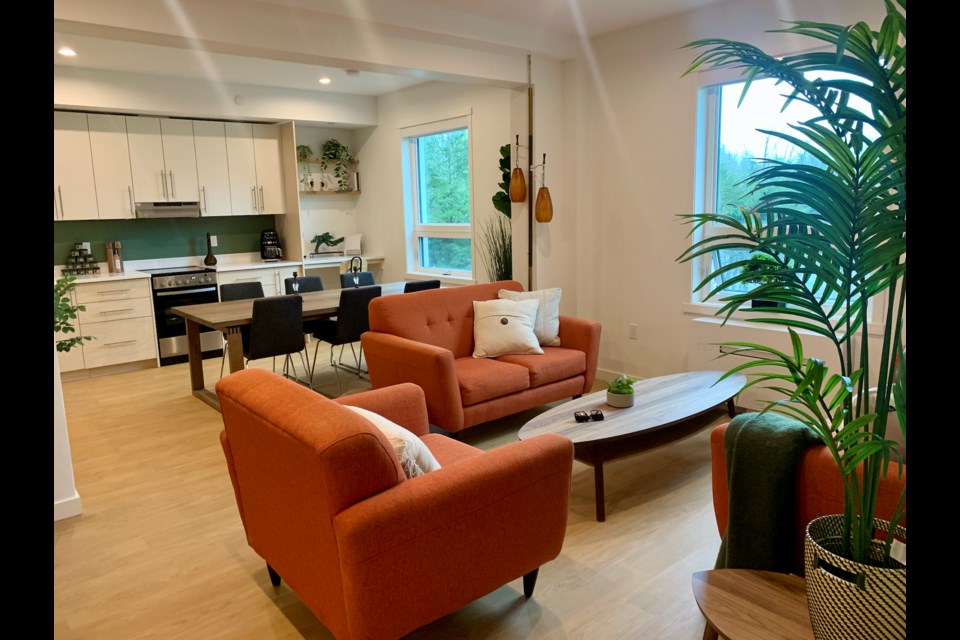Soon the brand new affordable homes will be filled with children sitting around a kitchen table, parents cooking dinner, and new locals relaxing in their bright living rooms while looking out at the Squamish River through their windows.
The Squamish Chief took a tour Monday, April 8, of the Esḵéḵxwi7ch tl'a Sp'áḵw'us Place social housing complex at 1139 Government Rd. on the Siyich'em Sḵwx̱wú7mesh Úxwumixw (Squamish Nation) reserve.
Residents will begin as soon as next week to move into the 27 self-contained units in the Nation’s Hiy̓ám̓ Housing Society development.
The housing is for Nation members, with priority given to vulnerable women and children experiencing or at risk of homelessness, in addition to Elders, people with disabilities, and vulnerable LGBTQ2SIA+ members.
The apartment building is over 50% modular. The Indigenous, female-led modular company NUQO Elevated Modular, which is based in West Vancouver, supplied the modular pieces.
The company also built the Estítkw Place (a safe place) housing development on Nation land on Capilano Road on the North Shore.
Modular means the units come with almost everything pre-constructed; even the shelving, windows and appliances are in when the units arrive.
Kindred Construction completed the Squamish build—the main floor—after the modular units arrived.
Module housing in Canada came out of the oil and gas sector, where it was originally used for workforce housing, said Rory Richards, CEO of NUQO Modular.
This gave some people a bad impression of it, Richards said, of the early iterations of worker accommodations.
But modular building is and can be done in "spectacular ways," she said.
"Like in this way; you'd never know that this wasn't a traditionally built building."
NUQO is also partnering on a project in Fernie for a new modular building that will contain up to 100 child-care spaces and affordable housing.
Given the combined child care and housing crises in many communities, such as Squamish, a modular building of child care can be paired with housing for the child-care staff above, Richards said.
Richards says modular housing creates significantly less waste and allows buildings to go up faster than traditional builds, which can take up to years.
"It took us 12 weeks to build in the factory. Five days to crane," Richards said, explaining how long it took to get the Squamish housing units onto the site.
Richards credits the Nation with supporting the company, which started in 2020, when others weren't so sure about the new start-up run by Aboriginal women. She said there can still be stereotypes in the minds of some in the construction world.
"It [was] really hard for us to get hired to get our first few jobs," she said. "And now because we have a portfolio—now that we've done it—now it's like ‘OK, gentlemen. We proved ourselves.’"
Each unit has a cedar wall as an homage to the Nation for their support.
"We gifted these to our Sḵwx̱wú7mesh cousins, just out of gratitude for giving us the privilege to make their homes and for believing in us."
Richards said having women at the helm of a construction project like the Squamish one does make a difference in the outcome.
"We're constantly thinking about, who's going to live here—the moms who are going to live here, and the kids who are going to live here, and what's the best layout for them. And where are they going to eat dinner, where are they going to do homework, where are you going to put their jackets. So, we work very, very closely with the architect [DIALOG]," she said.
"We are excited for the moms and families to come in and enjoy the space."
**Please note that this story has been corrected since it was first posted to clarify that the Squamish project was craned in five days, not five weeks, as first stated. The Squamish Chief apologizes for this error.



